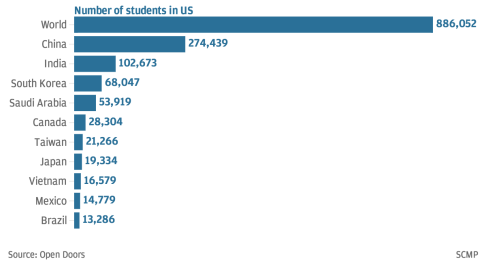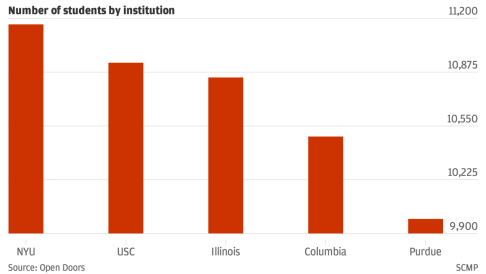Foreign student numbers in US reach record high, with almost one third from China
Number of international students at US institutions reaches record high, with Chinese students making up more than 30 per cent
PUBLISHED : Monday, 17 November, 2014, 1:01pm
UPDATED : Tuesday, 18 November, 2014, 3:28am
James Griffiths [email protected]

Graduates set next to Chinese flag during graduation ceremony at Fudan University in Shanghai. Photo: Reuters
The number of international students enrolled at US institutions has increased for the eighth year in a row, with China being the main driver of growth.
There are now 72 per cent more international students studying at US universities and colleges since 2000, according to this year’s Open Doors Report on International Educational Exchange, published in association with the US Bureau of Educational and Cultural Affairs.
The total number of international students enrolled in US higher education increased by 8 per cent to a record high of 886,052 students in 2013/14.

China was the primary driver of this growth, with student enrolments increasing by 17 per cent to more than 274,000 students. Chinese students now make up 31 per cent of all international students in the US, with more than double the number of students than India, at 102,673.
With 74 per cent of international students receiving the majority of their funding from sources outside the US, they are a boon to the American educational sector and economy at large, contributing more than US$27 billion, according to the US Department of Commerce.
International students are spread out across the United States, with all of the top 25 universities and all top 10 states hosting more international students than last year. California was the top state for the third year in a row, with more than 100,000 international students, followed by New York, Texas, Massachusetts and Illinois.

New York University (NYU), which opened a campus in Shanghai in 2012, rose from fourth place to become the number one institution for international students, followed by the University of Southern California, University of Illinois at Urbana-Champaign, Columbia University, and Purdue University.
Only one of the top five institutions was from the Ivy League, which has struggled to retain Chinese students in the past. A report published last year by the Centre for China and Globalisation found that one in four Chinese students attending the eight prestigious universities dropped out due to an inability to adapt to the new environment caused by differences in the educational system and language barriers.
Chinese students have a variety of reasons for seeking to study in the US, said Carla Shere, regional director of College Counselling at educational consultancy Enreach-CACS.
Shere told the South China Morning Post that some students "feel they will receive a more solid education [in the US] than they would in China."
One of her students told Shere that they felt "with the exception of a handful of excellent universities in China that were too difficult to be accepted to, the quality of colleges in China was not good and they 'wouldn't learn anything'."
"Chinese students (and their parents) continue to find the US the academic destination of choice because of both the outstanding reputation of individual universities and the unique style of US education," Peggy Blumenthal of the Institute of International Education, which publishes the annual Open Doors report, told the Post.
"In the US classroom, undergraduates as well as graduate students are expected to participate in discussions and express their own opinions, leading to a development of strong critical thinking skills and an ability to innovate that is highly valued by future employers."
While Blumental praised institutions which have opened branches in China, such as NYU, she said that "perhaps the most successful recruitment strategy ... has been the very positive feedback from successful Chinese alumni."

Chinese college graduates pose for their group graduation photograph at the Qingdao University, Shandong province. Photo: EPA
The number of Americans studying abroad also saw a minor increase, with 289,408 students taking part in the study abroad programme in 2012/13.
“International experience is one of the most important components of a 21st century education, and study abroad should be viewed as an essential element of a college degree,” said Allan Goodman, president of the Institute of International Education.
“Learning how to study and work with people from other countries and cultures also prepares future leaders to contribute to making the world a less dangerous place.”
